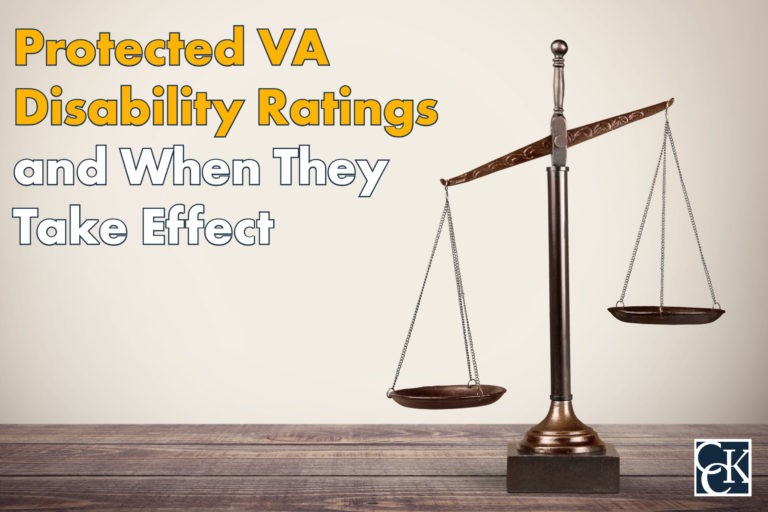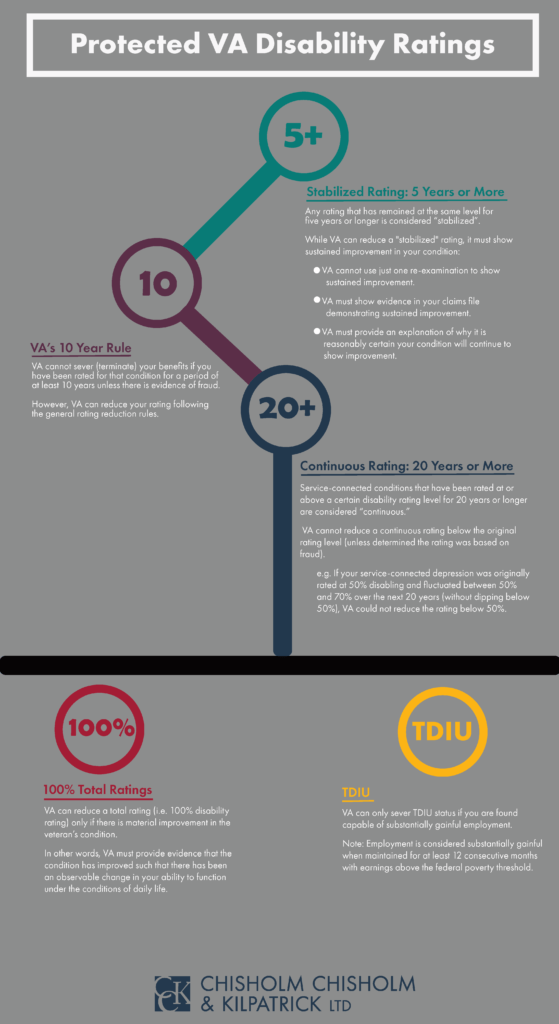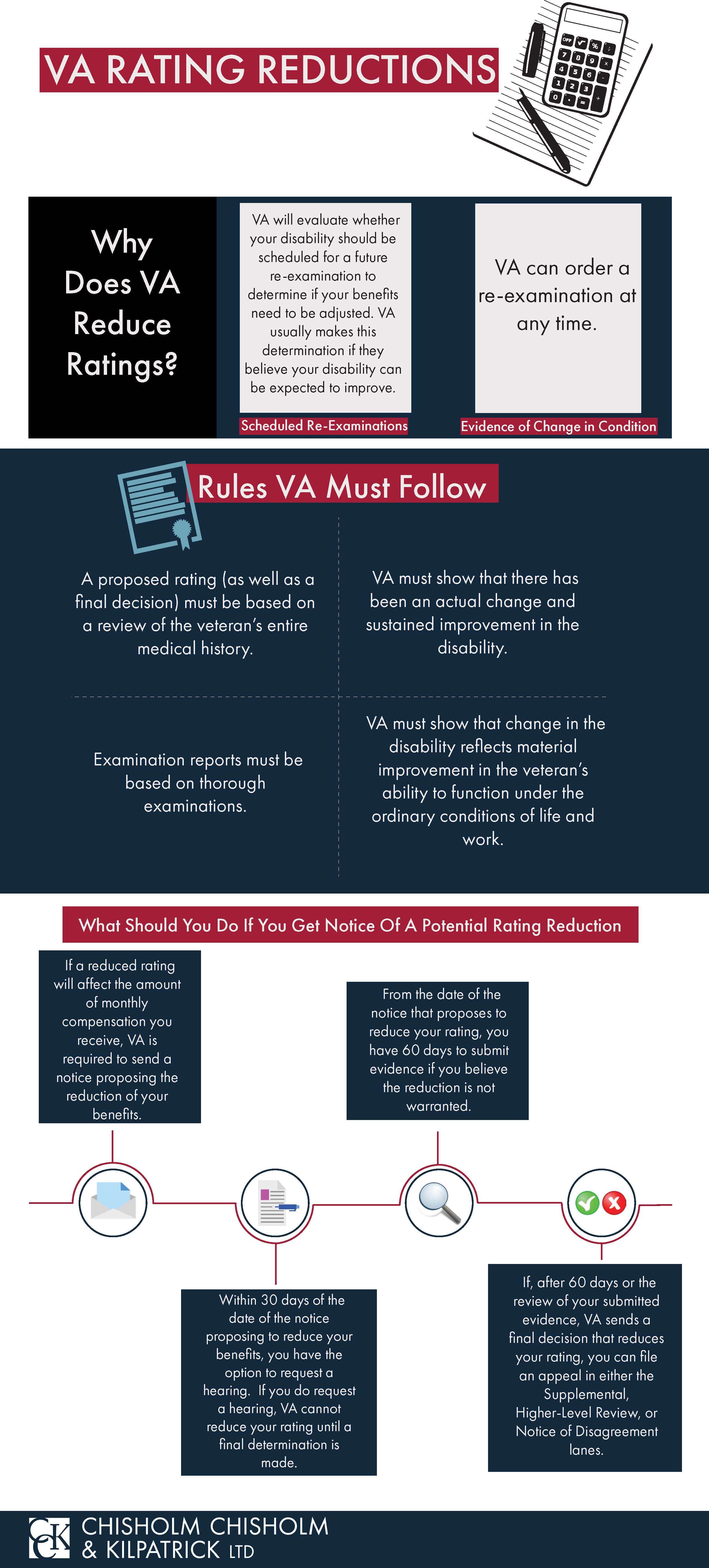Protected VA Disability Ratings: What They Are and When They Take Effect

CCK Law: Our Vital Role in Veterans Law
What Are VA Disability Ratings?
If a veteran experiences an injury or illness as a result of their military service, they may be eligible for service connection. When a veteran’s condition becomes service-connected, the Department of Veterans Affairs (VA) will issue a disability rating that determines the amount of disability compensation the veteran will receive.
A VA disability rating is a percentage, ranging from 0 to 100 percent, assigned to a service-connected disability based on the severity of the condition. VA uses the VA Schedule for Rating Disabilities (VASRD) – located in Part 4 of Title 38 in the United States Code of Federal Regulations – to assign diagnostic codes and disability ratings. The VASRD explains how certain conditions are evaluated for VA disability purposes.
Overall, VA disability ratings are meant to compensate veterans for the average impairment in earning capacity caused by their service-connected condition(s). Generally, the more severe the disability, the higher the VA disability rating.
When Can VA Reduce a Rating?
If VA anticipates that a veteran’s condition has improved or will improve over time, they will schedule a future reexamination of the veteran’s condition to potentially reduce their disability rating. The purpose of a rating reduction is to ensure that a veteran is being compensated for their condition’s current level of severity. If a veteran’s rating is reduced, their monthly compensation is also reduced.
It is important to note that a veteran must attend their VA reexamination if they wish to challenge their proposed rating reduction, because if they do not attend, VA will likely reduce their rating.
VA may initiate a rating reduction in the following scenarios:
- New evidence – If VA receives new and relevant medical evidence indicating a change in the veteran’s condition, they may schedule a reevaluation (i.e., C&P exam).
- Potential for improvement – As mentioned above, if VA anticipates improvement in the veteran’s condition, they may schedule a future examination. Reexaminations are generally scheduled for every two to five years.
How Are VA Ratings Reduced?
VA outlines the criteria for reducing ratings in 38 CFR § 3.105(e). Generally, a rating reduction must:
- Be based on a review of the veteran’s entire medical history.
- VA must show that there has been an actual change in the disability since the last rating decision.
- VA must show that change in the disability reflects a sustained improvement in the veteran’s ability to function under the ordinary conditions and stressors of life and work.
- The veteran must undergo a thorough compensation and pension (C&P) examination.
However, there are also situations in which a veteran’s disability rating is considered protected. In general, protected VA disability ratings cannot be terminated or reduced by VA.

What Are Protected VA Disability Ratings?
Congress has determined that, under certain conditions, it is not necessary for VA to expend resources to check on a veteran’s service-connected condition. Essentially, some ratings do not need to be periodically reevaluated.
A protected rating, broadly, is any VA disability rating that cannot be reduced or revoked by VA in the future. There are several types of protected ratings. Some ratings may become protected after a certain amount of years while others may be protected due to the nature of the condition.
VA’s 5-Year Rule: Stabilized Ratings
Any rating that has remained at the same level for five years or longer is considered stabilized. VA cannot reduce a stabilized rating unless the condition shows sustained improvement over time.
- VA cannot use just one reexamination to show sustained improvement. Rather, it must show through medical records and a C&P reexamination that the veteran is not just temporarily experiencing improvement; or
- VA must show that the evidence in a veteran’s claims file predominantly demonstrates sustained improvement. VA must provide an explanation of why they are reasonably certain that the condition will continue to show such improvement.
It is important to note that “sustained improvement” cannot be circumstantial or related to mitigating factors (i.e., temporary or episodic improvement, a less thorough exam, or temporary alleviation following prolonged rest).
VA’s 10-Year Rule
The VA disability 10-year rule states that VA cannot revoke a finding of service connection that has been in place for at least 10 years unless there is evidence of fraud.
In effect, this means that VA can no longer fully terminate benefits.
VA’s 20-Year Rule: Continuous Ratings
Service-connected conditions that have been rated at or above a certain disability rating level for 20 years or longer are considered continuous. VA cannot reduce a continuous rating below the original rating level unless the rating was based on fraud.
For example, if a veteran’s service-connected depression was originally rated at 50 percent disabling and fluctuated between 50 and 70 percent over the next 20 years (without dipping below 50 percent), VA cannot reduce the rating below 50 percent.
VA’s-55 Year Rule
Veterans who are over the age of 55 are protected from rating reductions in many situations. This is a case-by-case determination.
Are All 100% VA Ratings Protected?
No, all 100 percent VA disability ratings are not automatically protected. While some 100 percent ratings are protected in certain instances, not all 100 percent ratings are protected.
The VA 100% Total Ratings Rule
Veterans with 100 percent disability ratings, also known as total disability ratings, are determined to be fully disabled by VA. With some exceptions, such as special monthly compensation and aid and attendance, the 100 percent rating is the highest rating a veteran can receive.
Once a veteran has received a 100 percent rating, VA cannot reduce the rating unless there is material improvement in the veteran’s condition. VA must show through medical evidence that there has been an observable change in the veteran’s ability to function in daily life.
Can VA Reduce a Permanent and Total Rating?
For a veteran’s rating to be considered permanent and total (P&T), the condition must be permanent (i.e., chronic in nature and not likely to improve) and total (i.e., 100 percent disabling).
A permanent and total rating is one where VA does not require the veteran to undergo any further medical examinations. An example of a condition VA may consider permanently disabling is amputation.
It is important to note that P&T is not a protected rating. While unlikely, VA 100 percent P&T ratings can be reduced if VA becomes aware of any improvements in the condition. However, in most instances, VA assumes that veterans with P&T ratings will have to live with severely debilitating service-connected conditions, or the residuals of one, for the remainder of their lives. As such, these veterans will most likely receive VA compensation for the rest of their lives.

Is TDIU a Protected VA Disability Rating?
TDIU, or total disability based on individual unemployability, is a monthly benefit available to veterans who have a disability that prevents them from obtaining or maintaining substantially gainful employment. TDIU compensates veterans at the 100 percent rating level, even if their combined rating is less than 100 percent.
According to 38 CFR § 3.343(c), VA can only revoke TDIU status if “actual employability is established by clear and convincing evidence.” In other words, VA can only sever a veteran’s TDIU status if they have been found to be capable of substantially gainful employment.
It is important to note that for the employment to be considered substantially gainful, the veteran must be employed for at least 12 consecutive months and earning over the federal poverty threshold.
Other VA Reexamination Protections
Aside from the rules listed above, there are other instances in which veterans are protected from reexaminations by VA. No periodic reexamination should be scheduled when:
- The disability is established as static (not going to change);
- The disability is rated at the prescribed schedular minimum within its diagnostic code; or
- The combined disability rating would not be affected even if a future examination resulted in reduced evaluation for one or more condition. For example, if a veteran had a 10 percent rating among many other ratings, reducing or revoking the 10 percent rating would not affect the overall combined rating.
What if My Rating is Not Protected?
Some service-connected conditions can improve over time or with treatment. If this is the case, VA is legally allowed to reduce a disability rating to compensate a veteran for their current level of disability.
However, before reducing a veterans rating, VA must send veterans a letter proposing a reduction of benefits.
Challenging A Rating Reduction
Once a veteran receives notification of the proposed rating reduction, they have the option to challenge the reduction. To challenge a rating reduction, veterans must submit a timely response within VA’s deadlines. Veterans have:
- 60 days to submit evidence countering the reduction if they believe it is not warranted; and
- 30 days to request a hearing.
If a veteran chooses to request a hearing, VA cannot issue a new rating decision until the hearing is held. This allows the veteran additional time to submit new evidence. However, requesting a hearing is not necessary to challenge a VA proposed rating reduction – veterans can also simply submit new evidence within 60 days.
VA must consider all previous and new evidence when planning to reduce a rating. If, after this process, VA sends a final decision that reduces the veteran’s disability rating, the veteran can still appeal VA’s decision by requesting a Higher-Level Review, submitting a Supplemental Claim, or filing a Notice of Disagreement.

How CCK Can Help If VA Reduces Your Rating
Appealing a rating reduction can be challenging. If VA unfairly decides to reduce your rating, the experienced team of veterans’ advocates at Chisholm Chisholm & Kilpatrick may be able to help. Call our office today for a free case review.
About the Author
Share this Post

